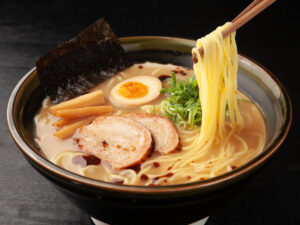Phở Bò (Beef Pho): Basic Information
Pronunciation
Alternative Name(s)
Dish Type
Course
Mealtime
Popular Phở Bò (Beef Pho) Variations
Phở Bò (Beef Pho): Ingredients and Preparation
Main Ingredients
Main Cooking Method
Preparation Process
Phở Bò (Beef Pho): A Deep Dive
Cultural Significance
Taste
Texture
Aroma
Color
Serving Style
Serving Temperature
Accompaniment
- In the Northern region: Scallions, lime wedges, cilantro, chili sauce, pickled garlic, quẩy (fried breadstick)
- In the South region: Bean sprouts, Thai basil, culantro, cilantro, chili peppers, hoisin sauce, sriracha sauce, lime wedges
Occasions
Seasons
Special Diets
Calories
Popularity
Popular Similar Dishes
- Ramen
- Bún Bò Huế
- Soto Ayam
- Kuyteav
- Taiwanese Beef Noodle Soup
- Caldo de Res
- Laksa
Popular Dining Area
Phở bò, or beef phở, is a famous Vietnamese noodle soup made from flat, thin rice noodles (called bánh phở), various cuts of beef, fresh herbs, and beef broth. It is the earliest as well as the most famous phở variation.
Upon the mention of “phở,” Vietnamese people automatically think of beef phở, which illustrates its status as a traditional dish and street food. Phở bò is also considered one of Vietnam’s national dishes.
Continue reading to discover all the helpful information about this Vietnamese specialty, such as its history and main ingredients. I will also delve into the types of beef used in beef phở.
Next, I will present you with the benefits and shortcomings of phở bò. Finally, you will know the answers to several common inquiries about phở bò and discover similar dishes.
Key Points
Phở Bò Images
What Is the History of Phở Bò?
Phở bò originated in Northern Vietnam in the early 20th century when beef, previously an unfamiliar kind of meat to the Vietnamese, became more popular thanks to French culinary influence. Phở bò is thought to be created by Vietnamese vendors, with possible inspiration from French and Cantonese cuisines.
Before the 1950s, this noodle soup was mainly enjoyed in the northern region. After the end of the Indochina War, phở bò was introduced to the southern region and adapted to local palates. The southern version of phở bò has a sweeter broth and a more diverse set of accompaniments.
After the Vietnam War, phở bò followed Vietnamese refugees to many countries around the world. Nowadays, this phở variation is one of the most internationally recognizable dishes in Vietnamese cuisine.
One of the factors contributing to the appeal of phở bò is the use of premium ingredients, which I will tell you about shortly.
What Is Phở Bò Made of?
Phở bò consists of the following 4 main groups of ingredients.
| Ingredients | Description |
|---|---|
| Noodles | Phở bò uses flat, thin rice noodles known as bánh phở The noodles have varying widths in different regions of Vietnam |
| Broth | Prepared by simmering beef bones and oxtail in water with various spices, such as cloves, cinnamon, star anise, cardamom, coriander seeds, fennel seed, charred onions, and charred ginger |
| Beef | Features thinly sliced beef Uses various cuts of beef in different variations |
| Accompaniments and add-ons | Northern version: scallions, lime wedges, cilantro, chili sauce, pickled garlic, quẩy (fried breadstick) Southern version: bean sprouts, Thai basil, culantro, cilantro, chili peppers, hoisin sauce, sriracha sauce, lime wedges |
Beef is a vital ingredient of phở bò, which can be made with various types of beef, from raw to cooked beef, whole cuts to minced meat. When ordering a bowl of phở bò, don’t forget to specify your preferred type of beef.
What Kinds of Beef Are Used in Phở Bò?
Below are the 11 most common types of beef that phở bò in Vietnam contains (you can order more than one kind of beef):
| Beef | Description |
|---|---|
| Tái chín | Combo of medium rare beef and fully cooked beefThe most popular type of beef in many phở restaurants |
| Tái | Beef cooked to medium-rareFurther cooked when submerged in the hot broth |
| Tái sống | Rare beef |
| Tái lăn | Beef lightly sauteed in pork fat (or vegetable oil) and garlic until medium-rare |
| Tái nạm | Medium-rare beef combined with a side of flank |
| Nạm | Beef flank steak |
| Nạm gầu | Beef brisket |
| Gân | Beef tendon |
| Sách | Beef tripe (the inner lining of a cow’s stomach) |
| Tiết | Beef blood cooked and solidified into cubes |
| Bò viên | Beef meatballs |
Using rich cuts of beef, phở bò comes with many benefits and drawbacks at the same time. Read on to discover what they are.
Pros and Cons of Eating Phở Bò
The consumption of phở bò offers the following advantages and disadvantages.
Pros
Cons
Your knowledge of phở bò is nearly complete; check out the FAQs section, and you will know everything there is to know about this Vietnamese delicacy.















Truc Tran (Kris)
Senior Food Editor
Expertise
Home Cooking, Meal Planning, Recipe Development, Baking and Pastry, Food Editor, Cooking-video Maker, Vietnamese Food Evaluation Expert
Education
Truc Tran (Kris), an experienced food writer and editor, is great at exploring and describing global cuisines, from simple street food to fancy dining. In her writing, she skillfully mixes different flavors, cooking methods, and culinary traditions, showing the unique character of various cultures through their food and drinks. On azcuisines.com, Kris highlights her knowledge, especially in Asian cuisine and worldwide traditional dishes.